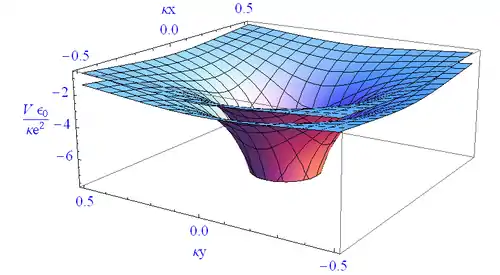Lindhard theory
Lindhard theory,[1][2] named after Danish professor Jens Lindhard,[3][4] is a method of calculating the effects of electric field screening by electrons in a solid. It is based on quantum mechanics (first-order perturbation theory) and the random phase approximation.
Thomas–Fermi screening can be derived as a special case of the more general Lindhard formula. In particular, Thomas–Fermi screening is the limit of the Lindhard formula when the wavevector (the reciprocal of the length-scale of interest) is much smaller than the Fermi wavevector, i.e. the long-distance limit.[2]
This article uses cgs-Gaussian units.
Formula
The Lindhard formula for the longitudinal dielectric function is given by
Here, is a positive infinitesimal constant, is and is the carrier distribution function which is the Fermi–Dirac distribution function for electrons in thermodynamic equilibrium. However this Lindhard formula is valid also for nonequilibrium distribution functions.
Analysis of the Lindhard formula
To understand the Lindhard formula, consider some limiting cases in 2 and 3 dimensions. The 1-dimensional case is also considered in other ways.
Long wavelength limit
First, consider the long wavelength limit ().
For the denominator of the Lindhard formula, we get
- ,
and for the numerator of the Lindhard formula, we get
- .
Inserting these into the Lindhard formula and taking the limit, we obtain
- ,
where we used , and .
(In SI units, replace the factor by .)
This result is the same as the classical dielectric function.
Static limit
Second, consider the static limit (). The Lindhard formula becomes
- .
Inserting the above equalities for the denominator and numerator, we obtain
- .
Assuming a thermal equilibrium Fermi–Dirac carrier distribution, we get
here, we used and .
Therefore,
Here, is the 3D screening wave number (3D inverse screening length) defined as .
Then, the 3D statically screened Coulomb potential is given by
- .
And the Fourier transformation of this result gives
known as the Yukawa potential. Note that in this Fourier transformation, which is basically a sum over all , we used the expression for small for every value of which is not correct.

For a degenerated Fermi gas (T=0), the Fermi energy is given by
- ,
So the density is
- .
At T=0, , so .
Inserting this into the above 3D screening wave number equation, we obtain
.
This is the 3D Thomas–Fermi screening wave number.
For reference, Debye–Hückel screening describes the nondegenerate limit case. The result is , the 3D Debye–Hückel screening wave number.
Long wavelength limit
First, consider the long wavelength limit ().
For the denominator of the Lindhard formula,
- ,
and for the numerator,
- .
Inserting these into the Lindhard formula and taking the limit of , we obtain
where we used , and .
Static limit
Second, consider the static limit (). The Lindhard formula becomes
- .
Inserting the above equalities for the denominator and numerator, we obtain
- .
Assuming a thermal equilibrium Fermi–Dirac carrier distribution, we get
here, we used and .
Therefore,
is 2D screening wave number(2D inverse screening length) defined as .
Then, the 2D statically screened Coulomb potential is given by
- .
It is known that the chemical potential of the 2-dimensional Fermi gas is given by
- ,
and .
So, the 2D screening wave number is
Note that this result is independent of n.
One dimension
This time, consider some generalized case for lowering the dimension. The lower the dimension is, the weaker the screening effect. In lower dimension, some of the field lines pass through the barrier material wherein the screening has no effect. For the 1-dimensional case, we can guess that the screening affects only the field lines which are very close to the wire axis.
Experiment
In real experiment, we should also take the 3D bulk screening effect into account even though we deal with 1D case like the single filament. The Thomas–Fermi screening has been applied to an electron gas confined to a filament and a coaxial cylinder.[5] For a K2Pt(CN)4Cl0.32·2.6H20 filament, it was found that the potential within the region between the filament and cylinder varies as and its effective screening length is about 10 times that of metallic platinum.[5]
See also
References
- Lindhard, Jens (1954). "On the properties of a gas of charged particles" (PDF). Danske Matematisk-fysiske Meddeleiser. 28 (8): 1–57. Retrieved 2016-09-28.
- N. W. Ashcroft and N. D. Mermin, Solid State Physics (Thomson Learning, Toronto, 1976)
- Andersen, Jens Ulrik; Sigmund, Peter (September 1998). "Jens Lindhard". Physics Today. 51 (9): 89–90. Bibcode:1998PhT....51i..89A. doi:10.1063/1.882460. ISSN 0031-9228.
- Smith, Henrik (1983). "The Lindhard Function and the Teaching of Solid State Physics". Physica Scripta. 28 (3): 287–293. Bibcode:1983PhyS...28..287S. doi:10.1088/0031-8949/28/3/005. ISSN 1402-4896.
- Davis, D. (1973). "Thomas-Fermi Screening in One Dimension". Physical Review B. 7 (1): 129–135. Bibcode:1973PhRvB...7..129D. doi:10.1103/PhysRevB.7.129.
General
- Haug, Hartmut; W. Koch, Stephan (2004). Quantum Theory of the Optical and Electronic Properties of Semiconductors (4th ed.). World Scientific Publishing Co. Pte. Ltd. ISBN 978-981-238-609-0.